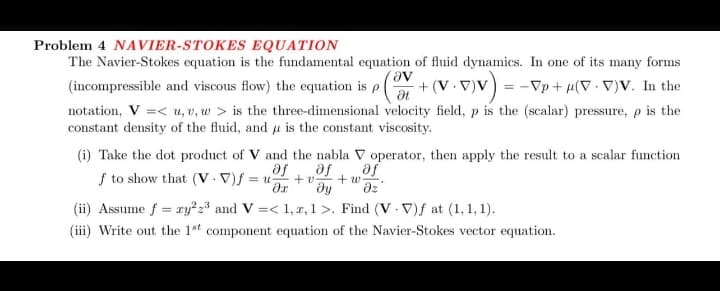Problem 4 NAVIER-STOKES EQUATION The Navier-Stokes equation is the fundamental equation of fluid dynamics. In one of its many forms (incompressible and viscous flow) the equation is p +(V.V)V) = -Vp+μ(V.V)V. In the av Ət notation, V =< u, v, w> is the three-dimensional velocity field, p is the (scalar) pressure, p is the constant density of the fluid, and u is the constant viscosity. (i) Take the dot product of V and the nabla V operator, then apply the result to a scalar function af af of f to show that (V.V)f=u) +v +w ər ду (ii) Assume fry²2³ and V =< 1, 2,1>. Find (VV)f at (1,1,1). = (iii) Write out the 1st component equation of the Navier-Stokes vector equation.
Problem 4 NAVIER-STOKES EQUATION The Navier-Stokes equation is the fundamental equation of fluid dynamics. In one of its many forms (incompressible and viscous flow) the equation is p +(V.V)V) = -Vp+μ(V.V)V. In the av Ət notation, V =< u, v, w> is the three-dimensional velocity field, p is the (scalar) pressure, p is the constant density of the fluid, and u is the constant viscosity. (i) Take the dot product of V and the nabla V operator, then apply the result to a scalar function af af of f to show that (V.V)f=u) +v +w ər ду (ii) Assume fry²2³ and V =< 1, 2,1>. Find (VV)f at (1,1,1). = (iii) Write out the 1st component equation of the Navier-Stokes vector equation.
Advanced Engineering Mathematics
10th Edition
ISBN:9780470458365
Author:Erwin Kreyszig
Publisher:Erwin Kreyszig
Chapter2: Second-order Linear Odes
Section: Chapter Questions
Problem 1RQ
Related questions
Question

Transcribed Image Text:Problem 4 NAVIER-STOKES EQUATION
The Navier-Stokes equation is the fundamental equation of fluid dynamics. In one of its many forms
Ꮩ .
(incompressible and viscous flow) the equation is p +(V. V)V) = -√₂ + μ(V · V)V. In the
Ət
notation, V =< u, v, w > is the three-dimensional velocity field, p is the (scalar) pressure, p is the
constant density of the fluid, and u is the constant viscosity.
(i) Take the dot product of V and the nabla V operator, then apply the result to a scalar function
af af af
f to show that (V.V)f=u) +v +w
əx ду əz
(ii) Assume f = ry²2 2³ and V=< 1, 2,1>. Find (V-V)f at (1,1,1).
(iii) Write out the 1st component equation of the Navier-Stokes vector equation.
Expert Solution
This question has been solved!
Explore an expertly crafted, step-by-step solution for a thorough understanding of key concepts.
Step by step
Solved in 3 steps with 3 images

Recommended textbooks for you

Advanced Engineering Mathematics
Advanced Math
ISBN:
9780470458365
Author:
Erwin Kreyszig
Publisher:
Wiley, John & Sons, Incorporated

Numerical Methods for Engineers
Advanced Math
ISBN:
9780073397924
Author:
Steven C. Chapra Dr., Raymond P. Canale
Publisher:
McGraw-Hill Education

Introductory Mathematics for Engineering Applicat…
Advanced Math
ISBN:
9781118141809
Author:
Nathan Klingbeil
Publisher:
WILEY

Advanced Engineering Mathematics
Advanced Math
ISBN:
9780470458365
Author:
Erwin Kreyszig
Publisher:
Wiley, John & Sons, Incorporated

Numerical Methods for Engineers
Advanced Math
ISBN:
9780073397924
Author:
Steven C. Chapra Dr., Raymond P. Canale
Publisher:
McGraw-Hill Education

Introductory Mathematics for Engineering Applicat…
Advanced Math
ISBN:
9781118141809
Author:
Nathan Klingbeil
Publisher:
WILEY

Mathematics For Machine Technology
Advanced Math
ISBN:
9781337798310
Author:
Peterson, John.
Publisher:
Cengage Learning,

